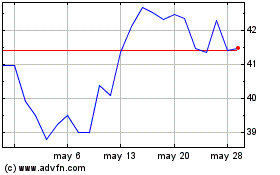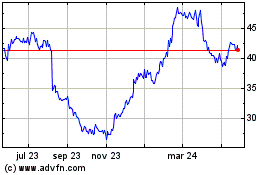By Suzanne Kapner and Zolan Kanno-Youngs
This article is being republished as part of our daily
reproduction of WSJ.com articles that also appeared in the U.S.
print edition of The Wall Street Journal (June 6, 2018).
The fashion designer Kate Spade -- whose sophisticated handbags
with a touch of whimsy were a rite of passage for a generation of
young, urban women -- was found dead from an apparent suicide at
her Manhattan apartment Tuesday morning.
The 55-year-old sold a controlling stake in her namesake brand
19 years ago, cut ties with it in 2007 and took time off from the
fashion business to focus on raising her daughter. She returned to
the industry in 2016, designing shoes and handbags under the brand
name Frances Valentine, which aimed to put an updated spin on her
breakthrough style.
Officials said the designer appeared to have hanged herself with
a scarf in her Park Avenue apartment at about 10:20 a.m. and was
found by her housekeeper.
At a separate press briefing Tuesday, NYPD Chief of Detectives
Dermot Shea said, "It appears at this point in time to be a tragic
case of apparent suicide. It is early in the investigation. There
was a suicide note left at the scene."
Ms. Spade was married to her business partner, Andy Spade, who
is the brother of actor David Spade. The couple have a 13-year-old
daughter, who wasn't home at the time of the incident, an official
said.
A spokeswoman for the Kate Spade brand said, "Our thoughts are
with Andy and the entire Spade family at this time."
Paula Fiedler, a neighbor in Ms. Spade's apartment building,
said "everyone was crying" when they were informed of her death
this morning.
Ms. Fiedler described Ms. Spade as a "determined person" whom
she would frequently see at the building gym. "There is nothing I
can say bad about her. She was warm, smiling, always willing to
share. All of us are so sad."
The Kate Spade brand has changed hands several times since the
founders sold a controlling stake to Neiman Marcus in 1999. The
high-end retail chain agreed to sell the brand in 2006 to Liz
Claiborne Inc., which later changed its corporate name to Kate
Spade & Co. The company was acquired last year by rival Coach
Inc., now known as Tapestry Inc.
Ms. Spade's new venture, Frances Valentine, hasn't fared as
well, people familiar with the situation said. Some retailers that
had initially carried the line such as Bloomingdale's have dropped
it.
Memorials surfaced on social media as news of the designer's
death spread, with people including designer Kenneth Cole and
singer Josh Groban expressing their condolences.
"My grandmother gave me my first Kate Spade bag when I was in
college. I still have it. Holding Kate's family, friends and loved
ones in my heart, " Chelsea Clinton said in a tweet.
Others used the surprising news to raise awareness about
suicide. "Kate Spade's tragic passing is a painful reminder that we
never truly know another's pain or the burden they carry," Ivanka
Trump said in a tweet.
The designer, born Katherine Noel Brosnahan in Kansas City, was
one of six children. Her mother was a former airline attendant who
later became a real-estate agent. The designer met her husband when
she was a student at Arizona State University, where she graduated
with a journalism degree. "Andy and I met in a little clothing
store" where they worked, Ms. Spade said in a 2016 interview with
The Wall Street Journal.
The designer said she showed an early flair for fashion. "I
would have my mother take me to vintage stores and wear leopard
swing coats and cigarette pants," she said in the interview. "In
Kansas City I looked very odd." She said she designs the way she
shops. "If I love it, I buy it."
The couple moved to New York, and Ms. Spade started at
Mademoiselle magazine as an assistant, "tying models' shoes" and
"getting hairstylists Snickers" as she worked her way up to fashion
editor, she told NPR in a 2017 interview.
In the early 1990s, at a Mexican restaurant, Mr. Spade asked
her, " 'What about handbags?' " she recalled. "And I said, 'Honey,
you just don't start a handbag company.' And he said, 'Why not? How
hard could it be?' "
Ms. Spade said she felt handbags at that time were too
complicated, and there was a dearth of bags with clean, simple
shapes. She began cutting patterns out of white paper and
eventually found a pattern maker and potato-sack company willing to
sell her fabric to turn her ideas into bags.
The couple debuted the bags in bright-colored utilitarian shapes
at a New York City trade show and landed just two buyers, leaving
Ms. Spade in tears and convinced she should quit. When she went
home and told Mr. Spade who the buyers were -- the retailers
Barneys New York and Fred Segal -- he said, " 'No, keep it going,'
" she recalled.
The couple, along with two partners, started the business in
1993 and opened their first handbag shop three years later. They
sold a 56% stake to Neiman Marcus in 1999 for $33.6 million.
"It became a cultural phenomenon," said William McComb, Liz
Claiborne's former chief executive, who said the brand resonated
far beyond its size. Kate Spade had less than $100 million in
annual sales when Liz Claiborne bought it, he said. Mr. McComb
oversaw the brand's expansion to include hundreds of retail stores
and new product lines such as men's accessories, stationery and
housewares. By the time Coach bought it last year, it had more than
$1 billion in annual sales.
Ultimately, though, growth of the Kate Spade brand lagged behind
that of Coach and Michael Kors Holdings Ltd., its rivals in
"affordable luxury" accessories.
The Coach-Kate Spade merger was an effort by the two companies
to adapt to slowing growth in handbags. Women have been trading
down to smaller, less expensive purses, and discounting has
pressured profits at both Kate Spade and Coach. Tapestry, which
also includes the shoe brand Stuart Weitzman, has nearly $6 billion
in annual sales and 1,300 retail stores.
The Kate Spade and Coach brands have been kept separate after
the corporate combination. Tapestry has been scaling back
distribution of Kate Spade merchandise to reduce discounting, much
as it did with Coach. Kate Spade's global comparable store sales
fell 9% for the most recent period, reflecting the pullback.
The Kate Spade store on Madison Avenue in New York was open for
business Tuesday, with a handful of customers perusing racks of
flowy summer dresses and strappy sandals. Today, Kate Spade has
more than 140 U.S. retail stores and more than 175 abroad.
"She was someone I looked up to in life," said JoJo Deady, of
New York City, a 26-year-old shopper at the store. "She was light,
happy and fun. This shows you don't know what anyone is going
through."
Rachel Beck, 53, was shopping in the neighborhood and decided to
stop in and pay her condolences to the store's staff. She said she
didn't know Ms. Spade was no longer involved in her eponymous
brand.
Carrying a cream-colored Kate Spade cross-body purse, Ms. Beck
decided to purchase another in a different color. "I thought it
would be a nice thing to do today," she said.
--Sara Germano contributed to this article.
Write to Suzanne Kapner at Suzanne.Kapner@wsj.com and Zolan
Kanno-Youngs at Zolan.Kanno-Youngs@wsj.com
(END) Dow Jones Newswires
June 06, 2018 02:47 ET (06:47 GMT)
Copyright (c) 2018 Dow Jones & Company, Inc.
Tapestry (NYSE:TPR)
Gráfica de Acción Histórica
De Jun 2024 a Jul 2024

Tapestry (NYSE:TPR)
Gráfica de Acción Histórica
De Jul 2023 a Jul 2024
